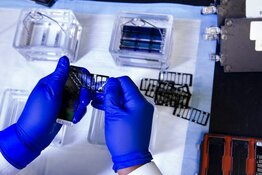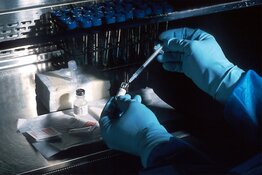The Life Sciences Report: Casey, how did you come to the idea of founding NeuroInsights? What was the concept, and why was this concept compelling?
Casey Lynch: It has been 10 years now; we established the company in 2003. My background is in neuroscience, and my co-founder and husband, Zack Lynch, is an economic geographer. Zack had been working on a book on how technologies evolve, looking at the agricultural revolution, the industrial revolution and the information revolution. We were talking about the next wave of technoeconomic development, and Zack said it would be neurotechnology. I said, "Well, let's see what's going on in the space now." We found some very exciting new developments, even 10 years ago, and these technologies have been evolving as we've addressed the space over the last decade.
TLSR: What was your initial objective?
CL: Companies involved in these technologies were being treated in silos, primarily. We wanted to bring together drug, device and diagnostic companies. The brain is an electrochemical organ, and in the past we've just thrown drugs at it, like you would at disorders in other organ systems. But you need to be more sophisticated than that. Neurotransmitter systems act differently in different parts of the brain. They act differently in different parts of the body. If you throw a nonspecific drug into the body, you get a lot of side effects and not much efficacy.
TLSR: Would you briefly describe your business model? What services do you offer, and for whom do you perform them?
CL: We offer a variety of stock market research, as well as a custom consulting practice. Our off-the-shelf products include our monthly newsletter, Neurotech Insights, which keeps subscribers up to date on product development, deals and financings. We produce a large market report every year, the Neurotechnology Industry Report, which looks at the pipelines of many companies working in neuroscience. We also host Neurotech Investing & Partnering conferences in the U.S. and Europe. Our goal is to bring together investors and partners from diverse areas.
TLSR: I want to ask you about your custom search capabilities. Is this something you might do for a venture capitalist who would like to know the size of a particular market or who competitors might be?
CL: Yes. If a venture capitalist wants to invest in a specific type of neurodevice or neuropharma company, we help identify the companies involved in that space, and which might be raising money. If the venture capitalist is looking at one product or opportunity in particular, we dig deeply into that company, its management team, its technology, the markets for the product, as well as the potential exits and predicted return for the investor.
TLSR: Diseases of the central and peripheral nervous systems have similar etiologies to other systems. They result from trauma, infection, genome- and epigenome-based phenomena. How is it that you can take all of these divergent disease indications, their causes and the technologies to treat them, and mold them into a single technology field?
CL: I think that the field is very different from fields dealing with other organs and diseases. We are addressing indications, causes and technologies as a unit because there are huge market opportunities out there. But more investments are required. If you look at the time it takes to develop these drugs, and the amount of money required, it's more than in other areas.
"Companies involved in neurotechnologies were being treated in silos; we wanted to bring together drug, device and diagnostic companies."
Back in 2006, Zack started the Neurotechnology Industry Organization, which has been lobbying up on Capitol Hill to make sure there's funding at ground level to move academic discoveries into companies. The idea is to bridge what we call the "valley of death," where discoveries languish because they're not far enough along for venture capital funding. Some of that lobbying resulted in the BRAIN Initiative that President Obama announced back in early April. This project has been launched with about $100M of the President's fiscal 2014 budget. We think this basic research is very important, but hope to see funding for programs that go further to help startups, like the National Institutes of Health's Blueprint Neurotherapeutics Network, for example.
TLSR: It strikes me, Casey, that basic research is more important in neuroscience or neurobiology than in any other single area, including cardiovascular disease and even oncology, where we have validated targets. Would you agree?
CL: Yes, that's exactly right. Basic research is critical, as is funding startups. To understand cancer, you can biopsy tumors and study them to see what proteins are being expressed to cause disease. In the brain, it's more difficult. The brain is much more of a black box, and our imaging and biomarker technology is still in its infancy. We have to be creative and we need a lot more basic information.
TLSR: Where are you seeing advances in the science right now? What promising technologies are you finding?
CL: We are seeing very exciting developments in neurostimulation technology. Investigators are stimulating specific parts of the brain and finding very specific neurotransmitter receptor subtypes, which enable them to target more precise areas of the brain. Companies like Medtronic Inc. (MDT:NYSE), traditionally a device company, are delivering drugs to specific parts of the brain using pumps. GlaxoSmithKline (GSK:NYSE) has just formed a venture fund to invest in stimulation technologies, and participated in a $27 million ($27M) round for SetPoint Medical, a private company developing vagus nerve stimulation for inflammatory disorders. We are excited about this crossover between drug and device companies, and the potential it has to change the way treatment is done.
TLSR: Cardiology has presented us with a quite elegant model of preventive medicine. No other specialty or branch of medicine has seen anything like it. People take statins and anti-hypertensive drugs on a chronic basis, and have modified their diets and quit smoking. Do you think in terms of a preventive medicine model in neurodegenerative disease—particularly the cognitive disorders?
CL: Prevention is important. We are certainly moving that way in Alzheimer's disease research. We're starting to understand more about prodromal states in schizophrenia and in Alzheimer's. Investigators and clinicians are identifying patients with mild cognitive impairment and trying to understand and predict who among them are going to develop Alzheimer's.
"We are addressing indications, causes and technologies as a unit because there are huge market opportunities out there."
On the other hand, I think it's a cop-out to say that we have to be preventative. That's what some people are doing out of frustration because disease-modifying therapies aren't working. What we need are good disease-modifying treatments to stop Alzheimer's in its tracks. It likely will be very difficult to reverse any of these neurodegenerative diseases, but our goal right now should still be to stop disease progression even after it has begun.
TLSR: Where are we now in the discovery process of locating and understanding the targets in neurodegenerative disease? If you wish, you can address this in terms of cognitive disorders such as Alzheimer’s or Parkinson's disease, or both.
CL: In Alzheimer's, we are in a retooling process. As you know, the beta amyloid-targeted therapies are failing. Some researchers noted that happening and made course corrections. Other companies have pursued it to the end. You can argue whether that was good or bad, but the important thing is that we're now getting the full story. We have learned from failure.
Right now it's important to think out of the box and pursue new targets. In fact, I just joined a company out of the University of California, San Francisco (UCSF) called Cortexyme Inc. (private) as interim CEO. We have a very novel target that has not been pursued before and I am very excited about its potential.
TLSR: Casey, now that we understand that we have been pursuing a sequel (aftereffect) in Alzheimer's—that being beta amyloid—instead of the origin of the disease, are we actually starting all over?
CL: No. Many scientists didn't subscribe to the beta amyloid theory from the beginning. There have been many camps in the Alzheimer's field, including tau, apolipoprotein E and others. I don't think we're starting from the beginning; rather, I think other areas will get more attention and funding.
TLSR: Is there development in the Alzheimer's area that you think is exciting?
CL: A neurodevice company called Functional Neuromodulation Ltd. (private) has developed a way to get around the molecular target issue utilizing deep brain stimulation. We may not know the molecular trigger for Alzheimer's, but we know the areas of the brain that are involved in memory and attention. Stimulating those areas may be very beneficial.
TLSR: Are you able to talk about other companies doing interesting work in neurotechnology?
CL: One exciting area of development is in treatment of depression. We've been slaves to serotonin reuptake inhibitors and their relatives for decades. Now a company called Naurex Inc. (private), as well AstraZeneca Plc (AZN:NYSE) and Janssen Pharmaceuticals Inc. (a unit of Johnson & Johnson (JNJ:NYSE)), have been pursuing a new class of therapeutics, namely NMDA (N-methyl-d-aspartate) modulators. This therapy is based on research showing that the anesthetic ketamine has a very dramatic and rapid effect on some patients with depression. However, it has terrible side effects, including psychosis.
"The idea is to bridge what we call the 'valley of death,' where discoveries languish because they're not far enough along for venture capital funding."
Back in early December, Naurex announced results from a phase 2a randomized, double-blind, placebo-controlled study (NCT01234558) of its novel NMDA receptor modulator, GLYX-13, in depression. A single dose of GLYX-13 showed a significant reduction in depression that lasted for a full week, and this was among very difficult-to-treat patients who had failed other options. The effect was very rapid, and GLYX-13 didn't seem to have the side effects that ketamine has. This is a beacon to the whole field, shining a light on the fact that we can get out of the ruts we get into with certain diseases. It takes time, and it takes money, but this is a real success story so far.
TLSR: How is GLYX-13 given?
CL: In this phase 2a trial, the dose was given intravenously, but the company just started a phase 1 trial with an oral follow-on.
TLSR: You mentioned that some exciting work was being done in neurostimulation. Can you share something around that technology?
CL: Actually, there are two areas in neurostimulation that are exciting. One is in responsive neurostimulation. Most stimulators in use today are on continuously. A company called NeuroPace Inc. (private) has been working for more than a decade on a responsive neurostimulator for epilepsy. The product is called the RNS System. This device can detect brain activity and deliver a series of stimulations to break up a seizure before it fully materializes. The company had a U.S. Food and Drug Administration review back in late February, after a very long wait. The review was positive, with the Neurological Devices Panel voting unanimously in favor. Now the company is waiting for action on its premarket approval (PMA) application. We hope to see an approval soon for this very exciting new device.
TLSR: Is it a deep brain stimulation product?
CL: The device uses a combination of electrocorticography (ECoG) to monitor brain activity and depth electrodes to target the seizure focus.
TLSR: Is there another concept or company that you want to mention?
CL: I would mention noninvasive neurostimulation, which is making a lot of strides. Cyberonics Inc. (CYBX:NASDAQ) has a vagus nerve stimulation device on the market for epilepsy, but has also made an investment in a privately held company called Cerbomed, which is developing a noninvasive vagus nerve stimulation device.
A company called ElectroCore Medical LLC (private) is developing a "disposable" vagus nerve stimulation device for migraine and asthma. The device costs on the order of a couple hundred dollars. The company believes devices like this can move into more of a prescription drug model.
TLSR: Is this an external device?
CL: Yes. The Cerbomed device targets the auricular branch of the vagus nerve through the skin of the ear, so it looks a little like an iPod with an earphone. Electrocore's is a handheld device, about the size of an asthma inhaler, that you hold up to your neck.
TLSR: The vagus nerve runs down the neck to the diaphragm, so this device uses a transcutaneous nerve stimulation-type process?
CL: Exactly.
TLSR: Thank you for all this, Casey.
CL: Thank you so much, George.
As founder and managing director of NeuroInsights, Casey Lynch works with companies to develop and implement strategic business plans and helps investors identify and profit from opportunities in neurotechnology. She is co-author of the Neurotechnology Industry Report, a comprehensive market analysis and strategic investment report on the brain industry, and is the managing editor of Neurotech Insights, a neurotechnology investment newsletter. She is interim CEO of the private Alzheimer's therapeutic development company Cortexyme Inc. Lynch is also on the board of directors of the Neurotechnology Industry Organization, a trade association for commercial neuroscience, and the co-founder and president of the Neurotechnology Development Foundation, a nonprofit formed to support translational research. Previously, Lynch was co-founder and CEO of Aspira Biosystems, a venture-backed drug discovery platform-company. Prior to building Aspira, Lynch oversaw toxicology screening and evaluated new product opportunities at Centaur Pharmaceuticals. There, she established disease model testing paradigms for multiple sclerosis, uveitis and other neurological disorders. Lynch has conducted primate preclinical trials for Alzheimer's disease treatment at the Wadsworth Medical Center in Los Angeles and researched the neurological basis of schizophrenia and epilepsy at UCLA. In addition to a bachelor's degree in neuroscience from UCLA, she has a master's degree in neuroscience from University of California, San Francisco, and has completed the management development for entrepreneurs program of the Anderson School of Business.
Want to read more Life Sciences Report interviews like this? Sign up for our free e-newsletter, and you'll learn when new articles have been published. To see a list of recent interviews with industry analysts and commentators, visit our Streetwise Interviews page.
DISCLOSURE:
1) George S. Mack conducted this interview for The Life Sciences Report and provides services to The Life Sciences Report as an independent contractor. He or his family own shares of the following companies mentioned in this interview: None.
2) The following companies mentioned in the interview are sponsors of The Life Sciences Report: None. Streetwise Reports does not accept stock in exchange for its services or as sponsorship payment.
3) Casey Lynch: I own or my family owns shares of the following companies mentioned in this interview: Cyberonics Inc., Cortexyme Inc. I personally am or my family is paid by the following companies mentioned in this interview: Cortexyme Inc. My company has a financial relationship with the following companies mentioned in this interview: None. I was not paid by Streetwise Reports for participating in this interview. Comments and opinions expressed are my own comments and opinions. I had the opportunity to review the interview for accuracy as of the date of the interview and am responsible for the content of the interview.
4) Interviews are edited for clarity. Streetwise Reports does not make editorial comments or change experts' statements without their consent.
5) The interview does not constitute investment advice. Each reader is encouraged to consult with his or her individual financial professional and any action a reader takes as a result of information presented here is his or her own responsibility. By opening this page, each reader accepts and agrees to Streetwise Reports' terms of use and full legal disclaimer.
6) From time to time, Streetwise Reports LLC and its directors, officers, employees or members of their families, as well as persons interviewed for articles and interviews on the site, may have a long or short position in securities mentioned and may make purchases and/or sales of those securities in the open market or otherwise.












































